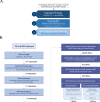Identity-by-descent analysis of a large Tourette's syndrome pedigree from Costa Rica implicates genes involved in neuronal development and signal transduction
- PMID: 36224258
- PMCID: PMC9763103
- DOI: 10.1038/s41380-022-01771-9
Identity-by-descent analysis of a large Tourette's syndrome pedigree from Costa Rica implicates genes involved in neuronal development and signal transduction
Abstract
Tourette Syndrome (TS) is a heritable, early-onset neuropsychiatric disorder that typically begins in early childhood. Identifying rare genetic variants that make a significant contribution to risk in affected families may provide important insights into the molecular aetiology of this complex and heterogeneous syndrome. Here we present a whole-genome sequencing (WGS) analysis from the 11-generation pedigree (>500 individuals) of a densely affected Costa Rican family which shares ancestry from six founder pairs. By conducting an identity-by-descent (IBD) analysis using WGS data from 19 individuals from the extended pedigree we have identified putative risk haplotypes that were not seen in controls, and can be linked with four of the six founder pairs. Rare coding and non-coding variants present on the haplotypes and only seen in haplotype carriers show an enrichment in pathways such as regulation of locomotion and signal transduction, suggesting common mechanisms by which the haplotype-specific variants may be contributing to TS-risk in this pedigree. In particular we have identified a rare deleterious missense variation in RAPGEF1 on a chromosome 9 haplotype and two ultra-rare deleterious intronic variants in ERBB4 and IKZF2 on the same chromosome 2 haplotype. All three genes play a role in neurodevelopment. This study, using WGS data in a pedigree-based approach, shows the importance of investigating both coding and non-coding variants to identify genes that may contribute to disease risk. Together, the genes and variants identified on the IBD haplotypes represent biologically relevant targets for investigation in other pedigree and population-based TS data.
© 2022. The Author(s).
Conflict of interest statement
CAM received travel funding from the Tourette Association of America, and was the co-chair of the Scientific Advisory Board for the TAA. The remaining authors report no biomedical financial interests or potential competing interests.
Figures


Similar articles
-
Elevated common variant genetic risk for tourette syndrome in a densely-affected pedigree.Mol Psychiatry. 2021 Dec;26(12):7522-7529. doi: 10.1038/s41380-021-01277-w. Epub 2021 Sep 15. Mol Psychiatry. 2021. PMID: 34526668 Free PMC article.
-
Ancestral haplotype reconstruction in endogamous populations using identity-by-descent.PLoS Comput Biol. 2021 Feb 26;17(2):e1008638. doi: 10.1371/journal.pcbi.1008638. eCollection 2021 Feb. PLoS Comput Biol. 2021. PMID: 33635861 Free PMC article.
-
Genomewide linkage analysis in Costa Rican families implicates chromosome 15q14 as a candidate region for OCD.Hum Genet. 2011 Dec;130(6):795-805. doi: 10.1007/s00439-011-1033-6. Epub 2011 Jun 21. Hum Genet. 2011. PMID: 21691774 Free PMC article.
-
L-histidine decarboxylase and Tourette's syndrome.N Engl J Med. 2010 May 20;362(20):1901-8. doi: 10.1056/NEJMoa0907006. Epub 2010 May 5. N Engl J Med. 2010. PMID: 20445167 Free PMC article.
-
Haplotype phasing of a bipolar disorder pedigree revealed rare multiple mutations of SPOCD1 gene in the 1p36-35 susceptibility locus.J Affect Disord. 2022 Aug 1;310:96-105. doi: 10.1016/j.jad.2022.04.150. Epub 2022 May 2. J Affect Disord. 2022. PMID: 35504398
Cited by
-
Tourette syndrome research highlights from 2022.F1000Res. 2023 Oct 23;12:826. doi: 10.12688/f1000research.135702.2. eCollection 2023. F1000Res. 2023. PMID: 37691732 Free PMC article. Review.
-
BICEP: Bayesian inference for rare genomic variant causality evaluation in pedigrees.Brief Bioinform. 2024 Nov 22;26(1):bbae624. doi: 10.1093/bib/bbae624. Brief Bioinform. 2024. PMID: 39656772 Free PMC article.
-
Are "mystical experiences" essential for antidepressant actions of ketamine and the classic psychedelics?Eur Arch Psychiatry Clin Neurosci. 2025 Aug;275(5):1333-1346. doi: 10.1007/s00406-024-01770-7. Epub 2024 Feb 27. Eur Arch Psychiatry Clin Neurosci. 2025. PMID: 38411629 Free PMC article. Review.
-
Whole Genome Sequencing of Pedigrees With High Density of Substance Use and Psychiatric Disorders: A Meeting Report.Genes Brain Behav. 2025 Feb;24(1):e70017. doi: 10.1111/gbb.70017. Genes Brain Behav. 2025. PMID: 39935334 Free PMC article.
-
The Psychiatric Genomics Consortium: discoveries and directions.Lancet Psychiatry. 2025 Aug;12(8):600-610. doi: 10.1016/S2215-0366(25)00124-5. Epub 2025 Jun 26. Lancet Psychiatry. 2025. PMID: 40582370 Review.
References
-
- Mataix-Cols D, Isomura K, Perez-Vigil A, Chang Z, Ruck C, Larsson KJ, et al. Familial risks of Tourette syndrome and chronic Tic disorders. a population-based cohort study. JAMA Psychiatry. 2015;72:787–93. - PubMed
Publication types
MeSH terms
Substances
Grants and funding
LinkOut - more resources
Full Text Sources
Medical

